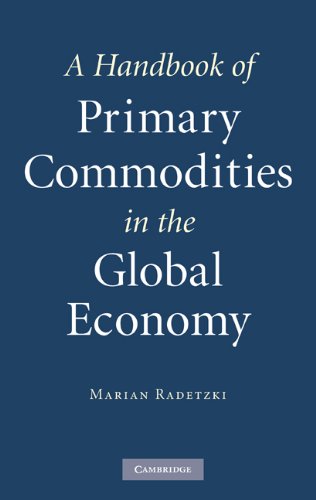Marian Radetzki0521880203, 9780521880206, 9780511388194
Table of contents :
Cover……Page 1
Half-title……Page 3
Title……Page 5
Copyright……Page 6
Contents……Page 7
Figures……Page 8
Tables……Page 9
Acknowledgments……Page 11
Background……Page 13
An opportune time to publish……Page 15
The readership……Page 17
1.1 Primary commodities in the economic development process……Page 19
1.2 Declining transport costs and the emergence of global commodity markets……Page 24
1.3 The fifty-year wave of public intervention and control inthe primary commodity markets……Page 27
1.4 Conclusion……Page 32
2.1 Commodity groups and their characteristics……Page 34
2.2 The importance of commodities in the international economy……Page 38
2.3 The provenance and destination of traded commodity supply……Page 43
2.4 The expansion of the rich world’s dependence on commodity imports, and the recent emergence of China as a globally dominant importer of commodities……Page 49
2.5 The main findings summarized……Page 55
3.1 Protectionism in raw materials: of great significance but mainly limited to agriculture……Page 59
3.2 What policies, by whom, and for what reasons?……Page 60
3.3 Measuring the extent of trade restrictions in international commodity trade……Page 63
3.4 Commodity processing: tariff escalation……Page 65
4.1 Factors determining price levels in the short and long run……Page 69
4.2 The blurred nature and instability of the short-run supply schedule……Page 73
Short-run instability……Page 76
Commodity booms……Page 78
The long-run price trends……Page 84
Commodity exchanges……Page 88
Bilateral contracts……Page 89
Producer-dictated prices……Page 91
Transfer prices……Page 92
4.5 The actual price quotations……Page 93
4.6 Exchange rates and commodity prices……Page 95
5.1 The commodity exchanges and the commodities traded there……Page 98
5.2 Instruments and functions……Page 102
Futures contracts……Page 103
Options……Page 106
Price formation……Page 107
5.3 The actors and their objectives……Page 109
Hedging……Page 110
Speculation in commodity markets……Page 112
Commodity investments……Page 114
5.4 Impact on price formation and other influences……Page 117
Impact on prices……Page 118
Other impacts……Page 122
6 The economics of exhaustible resource depletion……Page 123
6.1 The availability of reserves……Page 124
6.2 The evolution of long-run prices……Page 126
6.3 Evolution of the unit price of unexploited resources……Page 128
6.4 The cost evidence……Page 129
6.4 The evidence of depletion summarized……Page 133
6.5 Satisfying human needs……Page 134
7 Fears of, and measures to assure, supply security……Page 138
7.1 When will supply disruptions be particularly serious to the importing economy?……Page 139
7.2 The nature and severity of the problems caused by disrupted commodity supply……Page 142
7.3 Measures to alleviate the consequences of supply disruption……Page 144
Choice of suppliers……Page 147
Tighter relations with suppliers……Page 148
Promotion of domestic output……Page 150
Stockpiling of strategic metals in the USA and other countries……Page 151
The IEA emergency stockpile of oil……Page 153
7.4 A summary of findings……Page 154
8.1 The formal preconditions for successful cartel action……Page 156
8.2 Other preconditions for successful cartel action……Page 160
8.3 Actual experiences of commodity cartels in the 1970s……Page 165
Bauxite……Page 166
Uranium……Page 168
Copper and iron ore……Page 170
OPEC……Page 171
8.4 Conclusions……Page 176
9.1 Introduction……Page 178
9.2 How to define and quantify the state enterprise sector……Page 180
9.3 Motivations for public ownership in mineral industries……Page 182
9.4 The distinguishing characteristics of state-owned mineral firms and of the environments in which they operate……Page 184
Operations……Page 186
Financial environment and investment behavior……Page 188
9.5 The impact of state ownership on the national economy……Page 192
Control……Page 193
Mineral rent……Page 194
Other national goals……Page 195
Disillusion and privatization……Page 196
9.6 Implications for the international mineral markets……Page 198
10.1 Measurement of commodity dependence……Page 200
10.2 Export instability……Page 204
10.3 Extraction of fiscal revenue……Page 211
10.4 The Dutch disease and the resource curse……Page 218
The Dutch disease……Page 219
Resource curse……Page 222
10.5 Exchange rate policies in monoeconomies……Page 223
10.6 Conclusion: a general case for economic diversification?……Page 226
References……Page 228
Index……Page 238

Reviews
There are no reviews yet.